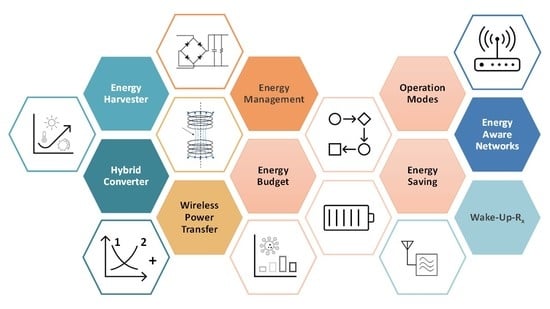Energy-Aware System Design for Autonomous Wireless Sensor Nodes: A Comprehensive Review
Abstract
1. Introduction
2. Challenges in System Design of Energy Autonomous Wireless Sensors
3. Energy Supply for Wireless Sensor Nodes
3.1. Overview of Energy Converters
3.2. Hybrid Converters
3.3. Wireless Power Transfer
4. Energy Management
4.1. Energy Budget Estimation and Benchmarking
4.2. Control of Operation Modes
- Store energy if the input is high, e.g., in solar supplied systems to bridge the night
- Use energy only if really needed, e.g., do not send data if the value has not changed
- Reduce the standby current as much as possible
- Switch off unnecessary parts
4.3. Energy Management for Single Sources
4.4. Hybrid Energy Management for Multiple Harvesters
4.5. Voltage Supervisor for Cold Start
4.6. Wake-Up Receiver for Sleeping/Idle Mode
5. Energy Saving on Network Level
5.1. Radio Optimization
5.2. Sleep/Wake-Up Protocols
5.3. Energy Efficient Routing
5.4. Data Reduction
6. Conclusions and Future Prospects
Author Contributions
Funding
Institutional Review Board Statement
Informed Consent Statement
Data Availability Statement
Conflicts of Interest
References
- Kanoun, O.; Keutel, T.; Viehweger, C.; Zhao, X.; Bradai, S.; Naifar, S.; Trigona, C.; Kallel, B.; Chaour, I.; Bouattour, G.; et al. Next Generation Wireless Energy Aware Sensors for Internet of Things: A Review. In Proceedings of the 15th International Multi-Conference on Systems, Signals and Devices (SSD), Hammamet, Tunisia, 19–22 March 2018. [Google Scholar]
- Min, M.; Wan, X.; Xiao, L.; Chen, Y.; Xia, M.; Wu, D.; Dai, H. Learning-Based Privacy-Aware off Loading for Healthcare IoT With Energy Harvesting. IEEE Internet Things J. 2019, 6, 4307–4316. [Google Scholar] [CrossRef]
- Peruzzi, G.; Pozzebon, A. A Review of Energy Harvesting Techniques for Low Power Wide Area Networks (LPWANs). Energies 2020, 13, 3433. [Google Scholar] [CrossRef]
- Kanoun, O. Energy Harvesting for Wireless Sensor Networks: Technology, Components and System Design; De Gruyter Oldenbourg: Berlin, Germany, 2019. [Google Scholar]
- Zhao, X.; Keutel, T.; Baldauf, M.; Kanoun, O. Energy harvesting for a wireless-monitoring system of overhead high-voltage power lines. Iet Gener. Transm. Distrib. 2013, 7, 101–107. [Google Scholar] [CrossRef]
- Naifar, S.; Bradai, S.; Viehweger, C.; Kanoun, O. Survey of electromagnetic and magnetoelectric vibration energy harvesters for low frequency excitation. Measurement 2017, 106, 251–263. [Google Scholar] [CrossRef]
- Bradai, S.; Naifar, S.; Kanoun, O. Development of a hybrid vibration converter for real vibration source. Tm-Tech. Mess. 2019, 86, 57–61. [Google Scholar] [CrossRef]
- Hui, S.Y.R.; Zhong, W.; Lee, C.K. A Critical Review of Recent Progress in Mid-Range Wireless Power Transfer. IEEE Trans. Power Electron. 2014, 29, 4500–4511. [Google Scholar] [CrossRef]
- Clerckx, B.; Zhang, R.; Schober, R.; Ng, D.W.K.; Kim, D.I.; Poor, H.V. Fundamentals of wireless information and power transfer: From RF energy harvester models to signal and system designs. IEEE J. Sel. Areas Commun. 2019, 37, 4–33. [Google Scholar] [CrossRef]
- Cheour, R.; Khriji, S.; Houssaini, D.E.; Baklouti, M.; Abid, M.; Kanoun, O. Recent Trends of FPGA used for Low-Power Wireless Sensor Network. IEEE Aerosp. Electron. Syst. Mag. 2019, 34, 28–38. [Google Scholar] [CrossRef]
- Chéour, R.; Khriji, S.; Götz, M.; Abid, M.; Kanoun, O. Accurate Dynamic Voltage and Frequency Scaling Measurement for Low-Power Microcontrollers in Wireless Sensor Networks. Microelectron. J. 2020, 105, 104874. [Google Scholar] [CrossRef]
- Kumberg, T.; Tannhaeuser, R.; Reindl, L. Wake-Up receiver with Equal-Gain antenna diversity. Sensors 2017, 17, 1961. [Google Scholar] [CrossRef]
- Khriji, S.; El Houssaini, D.; Kammoun, I.; Kanoun, O. Energy-efficient techniques in wireless sensor networks, Technology, Components and System Design. In Energy Harvesting for Wireless Sensor Networks, 1st ed.; Kanoun, O., Ed.; DE GRUYTER: Berlin, Germany, 2018; pp. 287–304. [Google Scholar]
- Bowen, C.R.; Kim, H.A.; Weaver, P.M.; Dunn, S. Piezoelectric and ferroelectric materials and structures for energy harvesting applications. Energy Environ. Sci. 2014, 7, 25–44. [Google Scholar] [CrossRef]
- Wang, X. Piezoelectric nanogenerators-Harvesting ambient mechanical energy at the nanometer scale. Nano Energy 2012, 1, 13–24. [Google Scholar] [CrossRef]
- Qin, Y.; Wang, X.; Wang, Z.L. Microfibre-nanowire hybrid structure for energy scavenging. Nature 2008, 451, 809–813. [Google Scholar] [CrossRef] [PubMed]
- Raghunathan, V.; Kansal, A.; Hsu, J.; Friedman, J.; Srivastava, M. Design considerations for solar energy harvesting wireless embedded systems. In Proceedings of the 4th International Symposium on Information Processing in Sensor Networks (IPSN), Los Angeles, CA, USA, 25–27 April 2005. Category number 05EX1086, Code 67416. [Google Scholar]
- Caliò, R.; Rongala, U.; Camboni, D.; Milazzo, M.; Stefanini, C.; de Petris, G.; Oddo, C.M. Piezoelectric energy harvesting solutions. Sensors 2014, 14, 4755–4790. [Google Scholar] [CrossRef]
- Sanad, M.F.; Shalan, A.E.; Abdellatif, S.O.; Serea, E.S.A.; Adly, M.S.; Ahsan, M.A. Thermoelectric Energy Harvesters: A Review of Recent Developments in Materials and Devices for Different Potential Applications. Top. Curr. Chem. 2020, 378, 48. [Google Scholar] [CrossRef]
- Wu, C.; Wang, A.C.; Ding, W.; Guo, H.; Wang, Z.L. Triboelectric Nanogenerator: A Foundation of the Energy for the New Era. Adv. Energy Mater. 2019, 9, 1802906. [Google Scholar] [CrossRef]
- Tian, J.; Chen, X.; Wang, Z.L. Environmental energy harvesting based on triboelectric nanogenerators. Nanotechnology 2020, 31, 242001. [Google Scholar] [CrossRef]
- Wang, K.; Wang, Y.; Sun, Y.; Guo, S.; Wu, J. Green Industrial Internet of Things Architecture: An Energy-Efficient Perspective. IEEE Commun. Mag. 2016, 54, 48–54. [Google Scholar] [CrossRef]
- Wang, Y.; Wang, H.; Xuan, J.; Leung, D.Y.C. Powering future body sensor network systems: A review of power sources. Biosens. Bioelectron. 2020, 166, 112410. [Google Scholar] [CrossRef]
- Dinis, H.; Mendes, P.M. A comprehensive review of powering methods used in state-of-the-art miniaturized implantable electronic devices. Biosens. Bioelectron. 2021, 172, 112781. [Google Scholar] [CrossRef]
- Karan, S.K.; Maiti, S.; Lee, J.H.; Mishra, Y.K.; Khatua, B.B.; Kim, J.K. Recent Advances in Self-Powered Tribo-/Piezoelectric Energy Harvesters: All-In-One Package for Future Smart Technologies. Adv. Mater. 2020, 30, 2004446. [Google Scholar]
- Zhang, T.; Yang, T.; Zhang, M.; Bowen, C.R.; Yang, Y. Recent Progress in Hybridized Nanogenerators for Energy Scavenging. iScience 2020, 23, 101689. [Google Scholar] [CrossRef] [PubMed]
- Singh, J.; Kaur, R.; Singh, D. A survey and taxonomy on energy management schemes in wireless sensor networks. J. Syst. Archit. 2020, 111, 101782. [Google Scholar] [CrossRef]
- Pasricha, S.; Ayoub, R.; Kishinevsky, M.; Mandal, S.K.; Ogras, U.Y. A survey on energy management for mobile and IoT devices. IEEE Des. Test 2020, 37, 7–24. [Google Scholar]
- Demirkol, I.; Ersoy, C.; Onur, E. Wake-up receivers for wireless sensor networks: Benefits and challenges. IEEE Wirel. Commun. 2009, 16, 88–96. [Google Scholar] [CrossRef]
- Pereira, F.; Correia, R.; Pinho, P.; Lopes, S.; Carvalho, N.B. Challenges in resource constrained IoT devices: Energy and communication as critical success factors for future IoT deployment. Sensors 2020, 20, 6420. [Google Scholar] [CrossRef]
- Akinaga, H. Recent advances and future prospects in energy harvesting technologies. Jpn. J. Appl. Phys. 2020, 59, 110201. [Google Scholar] [CrossRef]
- Viehweger, C.; Kanoun, O. Model-based estimation of the power income for the energy management of solar-based wireless sensor systems. Tech. Mess. 2016, 83, 503–510. [Google Scholar]
- Bradai, S.; Naifar, S.; Viehweger, C.; Kanoun, O. Electromagnetic Vibration Energy Harvesting for Railway Applications. MATEC Web Conf. 2018, 148, 12004. [Google Scholar] [CrossRef]
- Wave Energy. Available online: https://openei.org/wiki/Wave_Energy (accessed on 22 December 2020).
- Choi, J.; Jung, I.; Kang, C.-Y. A brief review of sound energy harvesting. Nano Energy 2019, 56, 169–183. [Google Scholar] [CrossRef]
- Zhang, Y.; Fang, J.; He, C.; Yan, H.; Wei, Z.; Li, Y. Integrated Energy-Harvesting System by Combining the Advantages of Polymer Solar Cells and Thermoelectric Devices. J. Phys. Chem. 2013, 117, 24685–24691. [Google Scholar] [CrossRef]
- Lorenzi, B.; Acciarri, M.; Narducci, D. Suitability of Electrical Coupling in Solar Cell Thermoelectric Hybridization. Designs 2018, 2, 32. [Google Scholar] [CrossRef]
- Leonov, V.; Torfs, T.; Vullers, R.J.M.; Van Hoof, C. Hybrid Thermoelectric–Photovoltaic Generators in Wireless Electroencephalography Diadem and Electrocardiography Shirt. J. Electron. Mater. 2010, 39, 1674–1680. [Google Scholar] [CrossRef]
- Luo, B.; Deng, Y.; Wang, Y.; Gao, M.; Zhu, W.; Hashim, H.T.; García-Cañadas, J. Synergistic photovoltaic–thermoelectric effect in a nanostructured CdTe/Bi2Te3 heterojunction for hybrid energy harvesting. RSC Adv. 2016, 6, 114046–114051. [Google Scholar] [CrossRef]
- Zheng, L.; Lin, Z.-H.; Cheng, G.; Wu, W.; Wen, X.; Lee, S.; Lin Wang, Z. Silicon-based hybrid cell for harvesting solar energy and raindrop electrostatic energy. Nano Energy 2014, 9, 291–300. [Google Scholar] [CrossRef]
- Wang, Y.; Duan, J.; Duan, Y.; Zhao, Y.; Pang, Z.; He, B.; Tang, Q. Interfacial engineering of hybridized solar cells for simultaneously harvesting solar and rain energies. J. Mater. Chem. A 2017, 5, 18551–18560. [Google Scholar] [CrossRef]
- Yang, Y.; Zhang, H.; Lin, Z.-H.; Liu, Y.; Chen, J.; Lin, Z.; Zhou, Y.S.; Wong, C.P.; Wang, Z.L. A hybrid energy cell for self-powered water splitting. Energy Environ. Sci. 2013, 6, 2429–2434. [Google Scholar] [CrossRef]
- Iqbal, M.; Khan, F.U. Hybrid vibration and wind energy harvesting using combined piezoelectric and electromagnetic conversion for bridge health monitoring applications. Energy Convers. Manag. 2018, 172, 611–618. [Google Scholar] [CrossRef]
- Guo, H.; He, X.; Zhong, J.; Zhong, Q.; Leng, Q.; Hu, C.; Chen, J.; Tian, L.; Xi, Y.; Zhou, J. A nanogenerator for harvesting airflow energy and light energy. J. Mater. Chem. A 2014, 2, 2079–2087. [Google Scholar] [CrossRef]
- Kim, M.-K.; Kim, M.-S.; Jo, S.-E.; Kim, Y.-J. Triboelectric–thermoelectric hybrid nanogenerator for harvesting frictional energy. Smart Mater. Struct. 2016, 25, 125007. [Google Scholar] [CrossRef]
- Zhang, Z.; Pang, H.; Georgiadis, A.; Cecati, C. Wireless Power Transfer—An Overview. IEEE Trans. Ind. Electron. 2019, 66, 1044–1058. [Google Scholar] [CrossRef]
- Kumar, R.V.S.N.; Sai, T.G. Investigation on Wireless Charging. Int. J. Sci. Res. Publ. 2017, 7, 807–813. [Google Scholar]
- Chaour, I.; Fakhfakh, A.; Kanoun, O. Enhanced Passive RF-DC Converter Circuit Efficiency for Low RF Energy Harvesting. Sensors 2017, 17, 546. [Google Scholar] [CrossRef] [PubMed]
- Lu, F.; Zhang, H.; Mi, C. A review on the recent development of capacitive wireless power transfer technology. Energies 2017, 10, 1752. [Google Scholar] [CrossRef]
- Chaour, I.; Bdiri, S.; Fakhfakh, A.; Kanoun, O. Modified rectifier circuit for high efficiency and low power RF energy harvester. In Proceedings of the 13th International Multi-Conference on Systems, Signals & Devices (SSD), Leipzig, Germany, 21–24 March 2016. [Google Scholar]
- Lu, X.; Wang, P.; Niyato, D.; Kim, D.I.; Han, Z. Wireless Charging Technologies: Fundamentals, Standards, and Network Applications. IEEE Commun. Surv. Tutor. 2016, 18, 1413–1452. [Google Scholar] [CrossRef]
- Jawad, A.M.; Nordin, R.; Gharghan, S.K.; Jawad, H.M.; Ismail, M. Opportunities and challenges for near-field wireless power transfer: A review. Energies 2017, 10, 1022. [Google Scholar] [CrossRef]
- Zhang, X.; Ho, S.L.; Fu, W.N. Quantitative design and analysis of relay resonators in wireless power transfer system. IEEE Trans. Magn. 2012, 48, 4026–4029. [Google Scholar] [CrossRef]
- Kallel, B.; Keutel, T.; Kanoun, O. MISO configuration efficiency in inductive power transmission for supplying wireless sensors. In Proceedings of the IEEE 11th International Multi-Conference on Systems, Signals & Devices (SSD14), Barcelona, Spain, 11–14 February 2014. [Google Scholar]
- Khan, S.R.; Pavuluri, S.K.; Cummins, G.; Desmullie, M.P.Y. Wireless Power Transfer Techniques for Implantable Medical Devices: A Review. Sensors 2020, 20, 3487. [Google Scholar] [CrossRef]
- Abou Houran, M.; Yang, X.; Chen, W. Magnetically Coupled Resonance WPT: Review of Compensation Topologies, Resonator Structures with Misalignment, and EMI Diagnostics. Electronics 2018, 7, 296. [Google Scholar] [CrossRef]
- Gati, E.; Kampitsis, G.; Manias, S. Variable frequency controller for inductive power transfer in dynamic conditions. IEEE Trans. Power Electron. 2016, 32, 1684–1696. [Google Scholar] [CrossRef]
- Liu, S.; Liu, M.; Han, S.; Zhu, X.; Ma, M. Tunable Class DC–DC Converter with High Efficiency and Stable Output Power for 6.78-MHz Wireless Power Transfer. IEEE Trans. Power Electron. 2018, 33, 6877–6886. [Google Scholar] [CrossRef]
- Porto, R.W.; Brusamarello, V.J.; Pereira, L.A.; de Sousa, F.R. Fine Tuning of an Inductive Link Through a Voltage-Controlled Capacitance. IEEE Trans. Power Electron. 2017, 32, 4115–4124. [Google Scholar] [CrossRef]
- Huang, Z.; Wong, S.-C.; Tse, C.K. Control Design for Optimizing Efficiency in Inductive Power Transfer Systems. IEEE Trans. Power Electron. 2018, 33, 4523–4534. [Google Scholar] [CrossRef]
- Kallel, B.; Bouattour, G.; Kanoun, O.; Trabelsi, H. Wireless power transmission via a multi-coil inductive system. In Energy Harvesting for Wireless Sensor Networks; Kanoun, O., Ed.; De Gruyter: Berlin, Germany, 2018; pp. 221–236. [Google Scholar]
- Kallel, B.; Kanoun, O.; Trabelsi, H. Large air gap misalignment tolerable multi-coil inductive power transfer for wireless sensors. IET Power Electron. 2016, 9, 1768–1774. [Google Scholar] [CrossRef]
- Zhang, Z.; Chau, K.T. Homogeneous Wireless Power Transfer for Move-and-Charge. IEEE Trans. Power Electron. 2015, 30, 6213–6220. [Google Scholar] [CrossRef]
- Bouattour, G.; Kallel, B.; Derbel, H.B.J.; Kanoun, O. Passive Peak Voltage Sensor for Multiple Sending Coils Inductive Power Transmission System. In Proceedings of the 2019 IEEE International Symposium on Measurements & Networking (M&N), Catania, Italy, 8–10 July 2019. [Google Scholar]
- Bouattour, G.; Elhawy, M.; Naifar, S.; Viehweger, C.; Ben Jmaa Derbel, H.; Kanoun, O. Multiplexed Supply of a MISO Wireless Power Transfer System for Battery-Free Wireless Sensors. Energies 2020, 13, 1244. [Google Scholar] [CrossRef]
- Kim, D.; Kim, S.; Moon, J.; Cho, I.; Ahn, D. Coupling Extraction and Maximum Efficiency Tracking for Multiple Concurrent Transmitters in Dynamic Wireless Charging. IEEE Trans. Power Electron. 2020, 35, 7853–7862. [Google Scholar] [CrossRef]
- Azad, A.; Tavakoli, R.; Pratik, U.; Varghese, B.; Coopmans, C.; Pantic, Z. A Smart Autonomous WPT System for Electric Wheelchair Applications with Free-Positioning Charging Feature. IEEE J. Emerg. Sel. Top. Power Electron. 2018, 8, 3516–3532. [Google Scholar] [CrossRef]
- Bouattour, G.; Ben Jemaa Derbel, H.; Kanoun, O. Multi-Parallel Sending Coils for Movable Receivers in Inductive Charging Systems. In Proceedings of the 16th International Multi-Conference on Systems, Signals & Devices (SSD), Istanbul, Turkey, 21–24 March 2019. [Google Scholar]
- Abdelmalik, B.; Dohler, M.; Watteyne, T.; Leung, K.K. MAC essentials for wireless sensor networks. IEEE Commun. Surv. Tutor. 2010, 12, 222–248. [Google Scholar]
- Götz, M.; Khriji, S.; Chéour, R.; Arief, W.; Kanoun, O. Benchmarking-Based Investigation on Energy Efficiency of Low-Power Microcontrollers. IEEE Trans. Instrum. Meas. 2020, 69, 7505–7512. [Google Scholar] [CrossRef]
- Chéour, R.; Khriji, S.; Kanoun, O. Microcontrollers for IoT: Optimizations, Computing Paradigms, and Future Directions. In Proceedings of the 2020 IEEE 6th World Forum on Internet of Things (WF-IoT), New Orleans, LA, USA, 2–16 June 2020; pp. 1–7. [Google Scholar]
- El Houssaini, D.; Khriji, S.; Besbes, K.; Kanoun, O. Performance Analysis of Received Signal Strength and Link Quality in Wireless Sensor Networks. In Proceedings of the 2018 15th International Multi-Conference on Systems, Signals & Devices (SSD), Hammamet, Tunisia, 19–22 March 2018. [Google Scholar]
- Khriji, S.; Chéour, R.; Goetz, M.; El Houssaini, D.; Kammoun, I.; Kanoun, O. Measuring energy consumption of a wireless sensor node during transmission: Panstamp. In Proceedings of the 2018 IEEE 32nd International Conference on Advanced Information Networking and Applications (AINA), Krakow, Poland, 16–18 May 2018. [Google Scholar]
- Mucchi, L.; Jayousi, S.; Martinelli, A.; Caputo, S.; Intrieri, E.; Gigli, G.; Gracchi, T.; Mugnai, F.; Favalli, M.; Fornaciai, A.; et al. A flexible wireless sensor network based on ultra-wide band technology for ground instability monitoring. Sensors 2018, 18, 2948. [Google Scholar]
- Zhen, C.; Liu, W.; Liu, Y.; Yan, A. Energy-efficient sleep/wake scheduling for acoustic localization wireless sensor network node. Int. J. Distrib. Sens. Netw. 2014, 10, 970524. [Google Scholar] [CrossRef]
- Amor, N.B.; Kanoun, O.; Derbel, N. Logically controlled energy management circuit. In Proceedings of the IEEE 9th International Multi-Conference on Systems, Signals and Devices, Chemnitz, Germany, 20–23 March 2012. [Google Scholar]
- Tse, K.H.K.; Chung, H.S.H. MPPT for Electromagnetic Energy Harvesters Having Nonnegligible Output Reactance Operating Under Slow-Varying Conditions. IEEE Trans. Power Electron. 2020, 35, 7110–7122. [Google Scholar] [CrossRef]
- Zouari, M.; Naifar, S.; Bouattour, G.; Derbel, N.; Kanoun, O. Energy management based on fractional open circuit and P-SSHI techniques for piezoelectric energy harvesting. Tm-Tech. Mess. 2019, 86, 14–24. [Google Scholar] [CrossRef]
- Bradai, S.; Naifar, S.; Trigona, C.; Baglio, S.; Kanoun, O. Electromagnetic transducer with bistable-RMSHI for energy harvesting from very weak kinetic sources. In Proceedings of the 2018 IEEE International Instrumentation and Measurement Technology Conference (I2MTC), Houston, TX, USA, 14–17 May 2018. [Google Scholar]
- Estrada-López, J.J.; Abuellil, A.; Zeng, Z.; Sánchez-Sinencio, E. Multiple input energy harvesting systems for autonomous IoT end-nodes. J. Low Power Electron. Appl. 2018, 8, 6. [Google Scholar] [CrossRef]
- Li, H.; Zhang, G.; Ma, R.; You, Z. Design and Experimental Evaluation on an Advanced Multisource Energy Harvesting System for Wireless Sensor Nodes. Sci. World J. 2014, 13. [Google Scholar] [CrossRef]
- Vankecke, C.; Assouère, L. Multisource and Battery-Free Energy Harvesting Architecture for Aeronautics Applications. IEEE Trans. Power Electron. 2015, 30, 3215–3227. [Google Scholar] [CrossRef]
- Dini, M.; Romani, A.; Filippi, M. A Nanocurrent Power Management IC for Multiple Heterogeneous Energy Harvesting Sources. IEEE Trans. Power Electron. 2015, 30, 5665–5680. [Google Scholar] [CrossRef]
- Colomer-Farrarons, J.; Miribel-Catala, P. A Multiharvested Self-Powered System in a Low-Voltage Low-Power Technology. IEEE Trans. Ind. Electron. 2011, 58, 4250–4263. [Google Scholar] [CrossRef]
- Ammar, M.B.; Fakhfakh, A.; Sahnoun, S.; Kanoun, O. Design of a DC-DC Boost Converter of Hybrid Energy Harvester for Low-Power Biomedical Applications. In Proceedings of the 17th International Multi-Conference on Systems, Signals & Devices, Monastir, Tunisia, 23–26 March 2020. [Google Scholar]
- Roscoe, N.M.; Judd, M.D. Harvesting Energy from Magnetic Fields to Power Condition Monitoring Sensors. IEEE Sens. J. 2013, 13, 2263–2270. [Google Scholar] [CrossRef]
- Colomer-Farrarons, J.; Miribel-Catala, P.; Saiz-Vela, A.; Puig-Vidal, M.; Samitier, J. Power-Conditioning circuitry for a self-Powered system based on micro PZT generators in a 0.13-µm low-voltage low-power technology. IEEE Trans. Ind. Electron. 2008, 55, 3249–3257. [Google Scholar]
- Stark, B.H.; Szarka, G.D. Start-up circuit with low minimum operating power for microwatt energy harvesters. IET Circuits Devices Syst. 2011, 5, 267–274. [Google Scholar] [CrossRef]
- Dayal, R.; Parsa, L. Modified electromagnetic microgenerator design for improved performance of low-voltage energy-harvesting systems. IET Power Electron. 2013, 6, 1751–1758. [Google Scholar] [CrossRef]
- Ching, N.N.H.; Wong, H.Y.; Li, W.J.; Leong, P.H.W.; Wen, Z. A laser-micromachined multi-modal resonating power transducer for wireless sensing systems. Sens. Actuators A 2002, 97, 685–690. [Google Scholar] [CrossRef]
- Yuen, S.C.; Lee, J.M.; Li, W.J.; Leong, P.H. An AA sized vibration-based microgenerator for wireless sensors. IEEE Pervasive Comput. 2007, 6, 64–72. [Google Scholar] [CrossRef]
- Edamoto, M.; Suzuki, Y.; Kasagi, N.; Kashiwagi, K.; Morizawa, Y.; Yokoyama, T.; Seki, T.; Oba, M. Low-Resonant-Frequency micro electret generator for energy harvesting application. In Proceedings of the 2009 IEEE 22nd International Conference on Micro Electro Mechanical Systems, Sorrento, Italy, 25–29 January 2009; pp. 1059–1062. [Google Scholar]
- Alghisi, D.; Ferrari, V.A. new nano-power trigger circuit for battery-less power management electronics in energy harvesting systems. Sens. Actuators A Phys. 2017, 263, 305–316. [Google Scholar] [CrossRef]
- Marinkovic, D.; Frey, A.; Kuehne, I. A new rectifier and trigger circuit for a piezoelectric microgenerator. Procedia Chem. 2009, 1, 1447–1450. [Google Scholar] [CrossRef][Green Version]
- Liu, G.; Fuentes, R. A self-powered power conditioning circuit for battery-free energy scavenging applications. Analog Integr. Circuits Signal Process. 2015, 83, 203–207. [Google Scholar] [CrossRef]
- Szarka, G.D.; Burrow, S.G. Ultralow power, fully autonomous boost rectifier for electromagnetic energy harvesters. IEEE Trans. Power Electron. 2013, 28, 3353–3362. [Google Scholar] [CrossRef]
- TS831: Micropower Voltage Supervisor Reset Active Low. Available online: https://www.st.com/en/reset-and-supervisor-ics/ts831.html (accessed on 7 December 2020).
- Götz, M.; Kanoun, O. Ultralow Power Voltage Supervisor for Ambient Power-Driven Microcontroller Systems. IEEE Trans. Ind. Electron. 2018, 66, 3843–3851. [Google Scholar] [CrossRef]
- Kim, H.; Cho, H.; Xi, Y.; Kim, M.; Kwon, S.; Lim, J.; Yang, Y. CMOS passive wake-up circuit for sensor network applications. Microw. Opt. Technol. Lett. 2010, 52, 597–600. [Google Scholar] [CrossRef]
- Ammar, Y.; Bdiri, S.; Derbel, F. An ultra-low power wake-up receiver with flip-flops based address decoder. In Proceedings of the 2015 IEEE 12th International Multi-Conference on Systems, Signals & Devices (SSD15), Mahdia, Tunisia, 16–19 March 2015. [Google Scholar]
- Magno, M.; Jelicic, V.; Srbinovski, B.; Bilas, V.; Popovici, E.M.; Benini, L. Design, Implementation, and Performance Evaluation of a Flexible Low-Latency Nanowatt Wake-Up Radio Receiver. IEEE Trans. Ind. Inform. 2016, 12, 633–644. [Google Scholar] [CrossRef]
- Bdiri, S.; Derbel, F. An Ultra-Low Power Wake-Up Receiver for Realtime constrained Wireless Sensor Networks. In Proceedings of the SENSOR 2015, Nürnberg, Germany, 19–21 May 2015; pp. 612–617. [Google Scholar]
- Bdiri, S.; Derbel, F.; Kanoun, O. An 868MHz 7.5 μW Wake-up Receiver with −60 dBm Sensitivity. J. Sens. Sens. Syst. 2016, 5, 433–446. [Google Scholar] [CrossRef]
- Prete, M.D.; Costanzo, A.; Magno, M.; Masotti, D.; Benini, L. Optimum Excitations for a Dual-Band Microwatt Wake-Up Radio. IEEE Trans. Microw. Theory Tech. 2016, 64, 4731–4739. [Google Scholar] [CrossRef]
- Yoon, D.Y.; Jeong, C.J.; Cartwright, J.; Kang, H.Y.; Han, S.K.; Kim, N.S.; Ha, D.S.; Lee, S.G. A New Approach to Low-Power and Low-Latency Wake-Up Receiver System for Wireless Sensor Nodes. IEEE J. Solid State Circuits 2012, 47, 2405–2419. [Google Scholar] [CrossRef]
- Bdiri, S.; Derbel, F.; Kanoun, O. A Tuned-RF Duty-Cycled Wake-Up Receiver with −90 dBm Sensitivity. Sensors 2018, 18, 86. [Google Scholar] [CrossRef]
- Petäjäjärvi, J.; Mikhaylov, K.; Vuohtoniemi, R.; Karvonen, H.; Iinatti, J. On the human body communications: Wake-up receiver design and channel characterization. EURASIP J. Wirel. Commun. Netw. 2016, 2016, 179. [Google Scholar] [CrossRef]
- Rault, T.; Bouabdallah, A.; Challal, Y. Energy efficiency in wireless sensor networks: A top-down survey. Comput. Netw. 2014, 67, 104–122. [Google Scholar] [CrossRef]
- Jayakrishna, P.S.; Sudha, T. Energy efficient wireless sensor network assisted spectrum sensing for cognitive radio network. In Proceedings of the 2017 IEEE International Conference on Intelligent Techniques in Control, Optimization and Signal Processing (INCOS), Srivilliputhur, India, 23–25 March 2017; pp. 1–7. [Google Scholar]
- Joshi, G.P.; Nam, S.Y.; Kim, S.W. Cognitive radio wireless sensor networks: Applications, challenges, and research trends. Sensors 2013, 13, 11196–11228. [Google Scholar] [CrossRef]
- Alamri, M.A. An efficient cooperative technique for power-constrained multiuser wireless network. Telecommun. Syst. 2018, 69, 263–271. [Google Scholar] [CrossRef]
- Cevik, T.; Gunagwera, A. A directional multicasting-based architecture for wireless sensor networks. Int. J. Electron. 2019, 106, 1441–1462. [Google Scholar] [CrossRef]
- Abo-Zahhad, M.; Farrag, M.; Ali, A. Optimization of Transmitted Power and Modulation Level for Minimizing Energy Consumption in Wireless Sensor Networks. Wirel. Pers. Commun. 2017, 96, 4047–4062. [Google Scholar] [CrossRef]
- Hsia, K.; Hung, C.; Chang, H.T.; Lai, Y. Transmission Power Control for Wireless Sensor Network. J. Robot. Netw. Artif. Life 2017, 3, 279–282. [Google Scholar] [CrossRef]
- Shabaneh, A.A.A.; Ali, A.M.; Ng, C.K.; Noordin, N.K.; Sali, A.; Yaacob, M.H. Review of Energy Conservation Using Duty Cycling Schemes for IEEE 802.15.4 Wireless Sensor Network (WSN). Wirel. Pers. Commun. 2014, 77, 589–604. [Google Scholar] [CrossRef]
- Han, K.; Luo, J.; Liu, Y.; Vasilakos, A.V. Algorithm design for data communications in duty-cycled wireless sensor networks: A survey. IEEE Commun. Mag. 2013, 51, 107–113. [Google Scholar] [CrossRef]
- Du, Y.; Xia, J.; Gong, J.; Hu, X. An Energy-Efficient and Fault-Tolerant Topology Control Game Algorithm for Wireless Sensor Network. Electronics 2019, 8, 1009. [Google Scholar] [CrossRef]
- El Houssaini, D.; Khriji, S.; Besbes, K.; Kanoun, O. Wireless sensor networks in agricultural applications. In Energy Harvesting for Wireless Sensor Networks; Kanoun, O., Ed.; De Gruyter: Berlin, Germany, 2018; pp. 323–342. [Google Scholar]
- Khriji, S.; Houssaini, D.E.; Kammoun, I.; Besbes, K.; Kanoun, O. Energy-Efficient Routing Algorithm Based on Localization and Clustering Techniques for Agricultural Applications. IEEE Aerosp. Electron. Syst. Mag. 2019, 34, 56–66. [Google Scholar] [CrossRef]
- Nguyen, L.; Nguyen, H.T. Mobility based network lifetime in wireless sensor networks: A review. Comput. Netw. 2019, 174, 107236. [Google Scholar] [CrossRef]
- Nakas, C.; Kandris, D.; Visvardis, G. Energy Efficient Routing in Wireless Sensor Networks: A Comprehensive Survey. Algorithms 2020, 13, 72. [Google Scholar] [CrossRef]
- Haque, M.; Ahmad, T.; Imran, M. Review of Hierarchical Routing Protocols for Wireless Sensor Networks. In Intelligent Communication and Computational Technologies; Hu, Y.C., Tiwari, S., Mishra, K., Trivedi, M., Eds.; Springer: Singapore, 2018; pp. 237–246. [Google Scholar]
- Kang, B.; Choo, H. An energy-efficient routing scheme by using GPS information for wireless sensor networks. Int. J. Sens. Netw. 2018, 26, 136–143. [Google Scholar] [CrossRef]
- Alharbe, N.; Abdullah, M. Routing Protocols for Dense Wireless Sensor Networks: Characteristics and Challenges. J. Telecommun. Electron. Comput. Eng. 2017, 9, 7–13. [Google Scholar]
- Liu, X.; Zhu, R.; Anjum, A.; Wang, J.; Zhang, H.; Ma, M. Intelligent data fusion algorithm based on hybrid delay-aware adaptive clustering in wireless sensor networks. Future Gener. Comput. Syst. 2020, 104, 1–14. [Google Scholar] [CrossRef]
- Khriji, S.; Raventos, G.V.; Kammoun, I.; Kanoun, O. Redundancy Elimination for Data Aggregation in Wireless Sensor Networks. In Proceedings of the 2018 15th International Multi-Conference on Systems, Signals & Devices (SSD), Hammamet, Tunisia, 19–22 March 2018; pp. 28–33. [Google Scholar]
- Zheng, J.; Bie, H.; Xu, D.; Lei, C.; Zhang, X. Work in progress: Data compression of wireless sensor network employing Kalman filter and QC-LDPC codes. In Proceedings of the 9th International Conference on Communications and Networking in China, Maoming, China, 14–16 August 2014; pp. 18–21. [Google Scholar]
- Sparka, H.; Naumann, R.; Dietzel, S.; Scheuermann, B. Effective Lossless Compression of Sensor Information in Manufacturing Industry. In Proceedings of the 2017 IEEE 42nd Conference on Local Computer Networks (LCN), Singapore, 9–12 October 2017. [Google Scholar]
- Yoon, I.; Kim, H.; Noh, D.K. Adaptive Data Aggregation and Compression to Improve Energy Utilization in Solar-Powered Wireless Sensor Networks. Sensors 2017, 17, 1226. [Google Scholar] [CrossRef] [PubMed]
- Skhiri, M.; Bdiri, S.; Derbel, F. Power Aware Wireless Sensor Networks based on Compressive Sensing. In Proceedings of the 2018 IEEE International Instrumentation and Measurement Technology Conference (I2MTC), Houston, TX, USA, 14–17 May 2018. [Google Scholar]
- Ben Arbi, I.; Derbel, F.; Strakosch, F. Forecasting Methods to Reduce Energy Consumption in WSN. In Proceedings of the IEEE 2017 IEEE International Instrumentation and Measurement Technology Conference (I2MTC), Turin, Italy, 22–25 May 2017. [Google Scholar]
- Strakosch, F.; Derbel, F. Fast and Efficient Dual-Forecasting Algorithm for Wireless Sensor Networks. In Proceedings of the SENSOR 2015, Nürnberg, Germany, 19–21 May 2015; pp. 859–863. [Google Scholar]
- Shu, T.; Xia, M.; Chen, J.; Silva, C. An Energy Efficient Adaptive Sampling Algorithm in a Sensor Network for Automated Water Quality Monitoring. Sensors 2017, 17, 2551. [Google Scholar] [CrossRef]
- Singh, A.; Nagaraju, A. Low latency and energy efficient routing-aware network coding-based data transmission in multi-hop and multi-sink WSN. Ad Hoc Netw. 2020, 107, 102182. [Google Scholar] [CrossRef]
- Puneeth, D.; Kulkarni, M. Data Aggregation using Compressive Sensing for Energy Efficient Routing Strategy. Procedia Comput. Sci. 2020, 171, 2242–2251. [Google Scholar] [CrossRef]
- Fan, F.R.; Tang, W.; Wang, Z.L. Flexible Nanogenerators for Energy Harvesting and Self-Powered Electronics. Adv. Mater. 2016, 28, 4283–4305. [Google Scholar] [CrossRef]
- Wu, Z.; Cheng, T.; Wang, Z.L. Self-powered sensors and systems based on nanogenerators. Sensors 2020, 20, 2925. [Google Scholar] [CrossRef]
- Zhou, X.; Parida, K.; Halevi, O.; Magdassi, S.; Lee, P.S. All 3d printed stretchable piezoelectric nanogenerator for self-powered sensor application. Sensors 2020, 20, 6748. [Google Scholar] [CrossRef]
- Wen, Z.; Yeh, M.-H.; Guo, H.; Wang, J.; Zi, Y.; Xu, W.; Deng, J.; Zhu, L.; Wang, X.; Hu, C.; et al. Self-powered textile for Wearable electronics by hybridizing fiber-shaped nanogenerators, solar cells, and supercapacitors. Sci. Adv. 2016, 2, 1600097. [Google Scholar] [CrossRef]
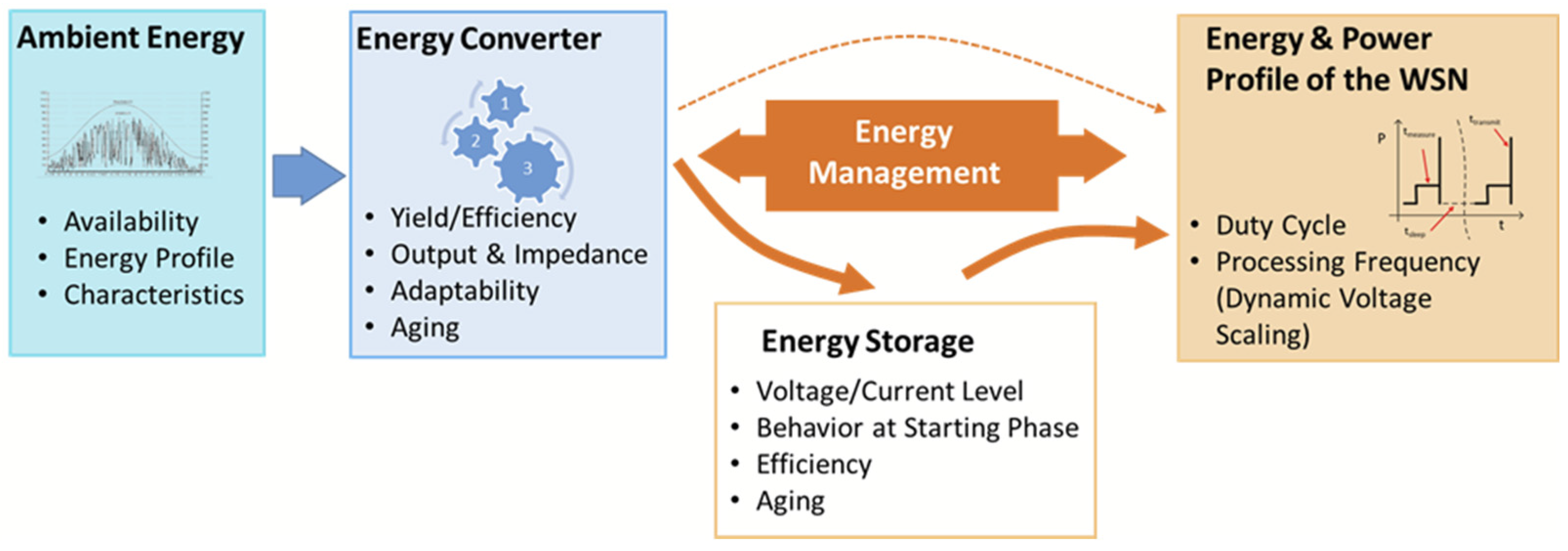
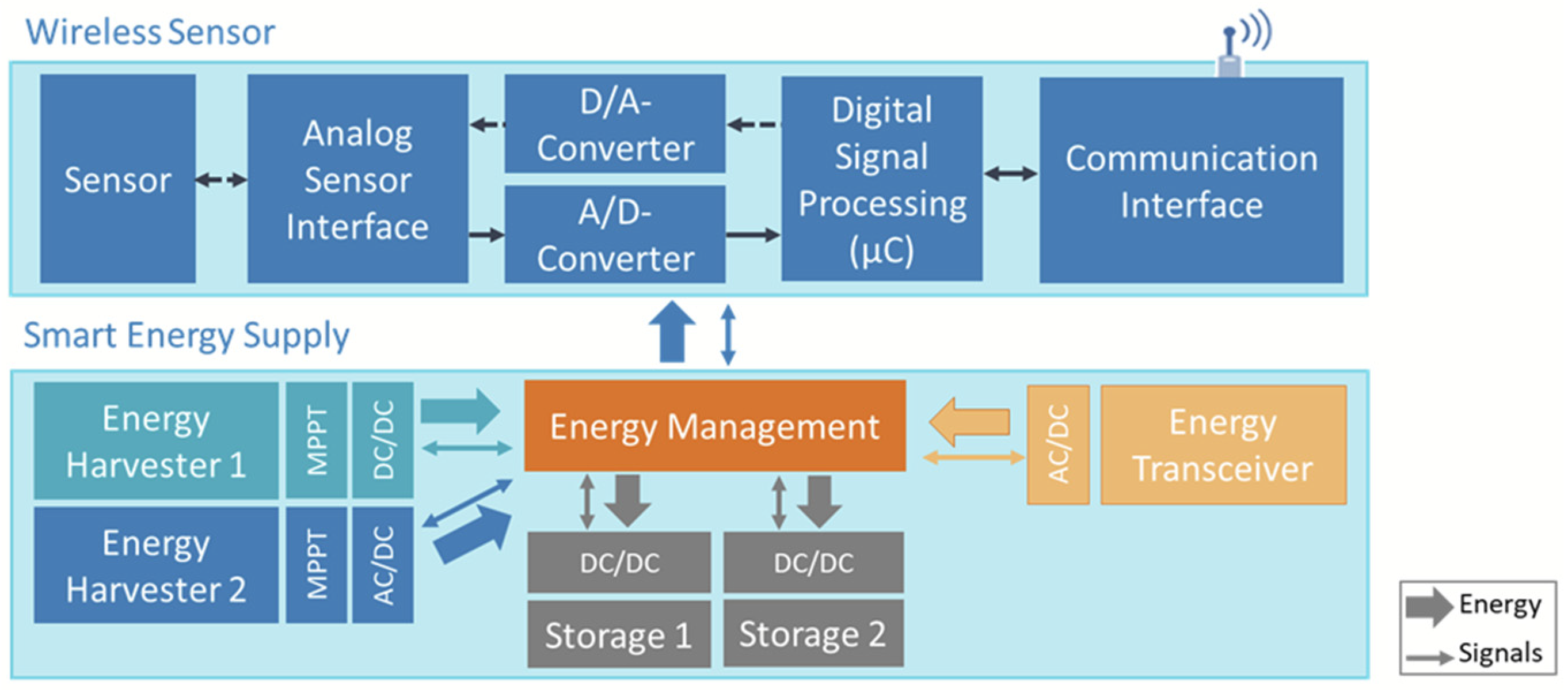
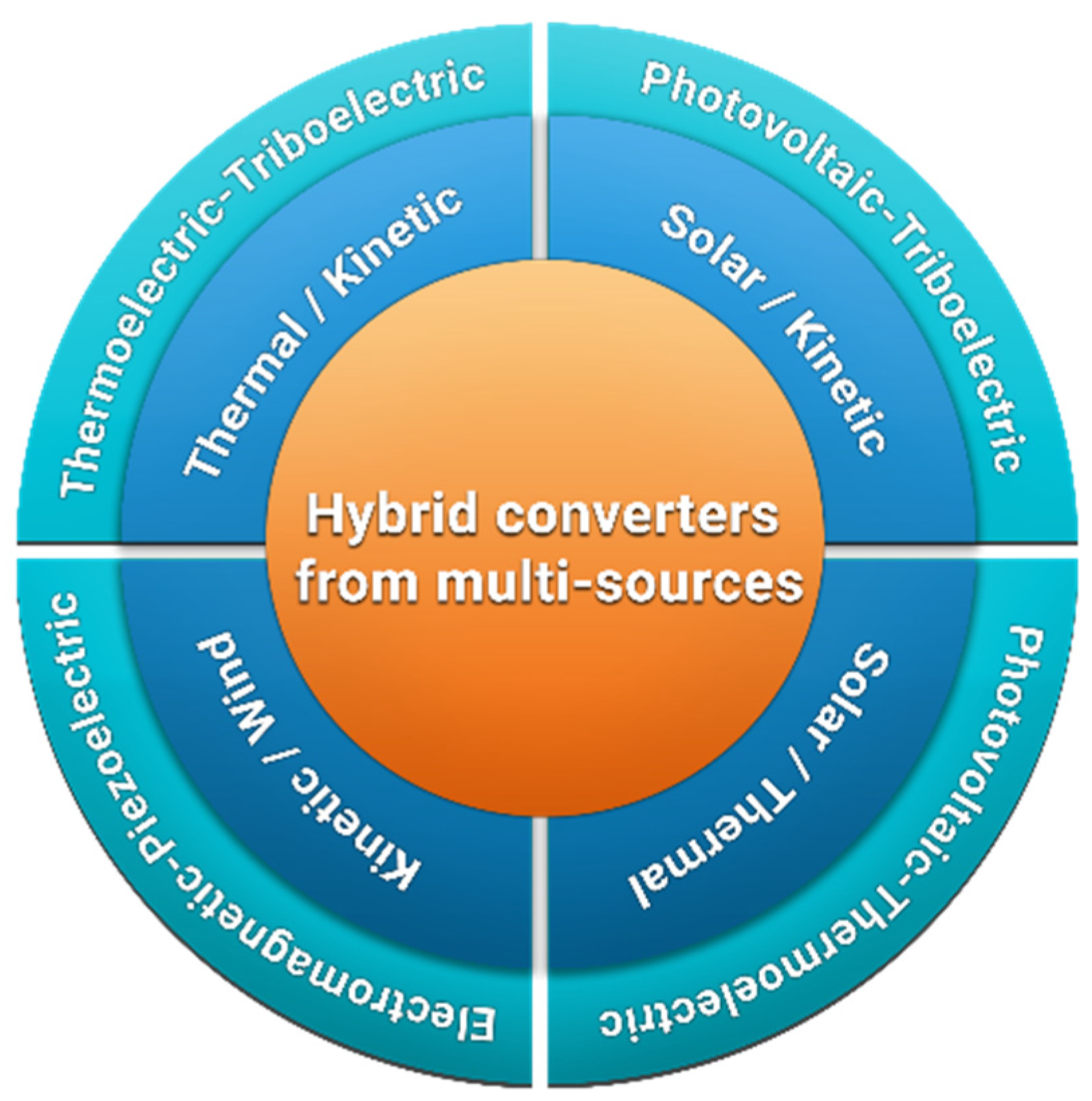






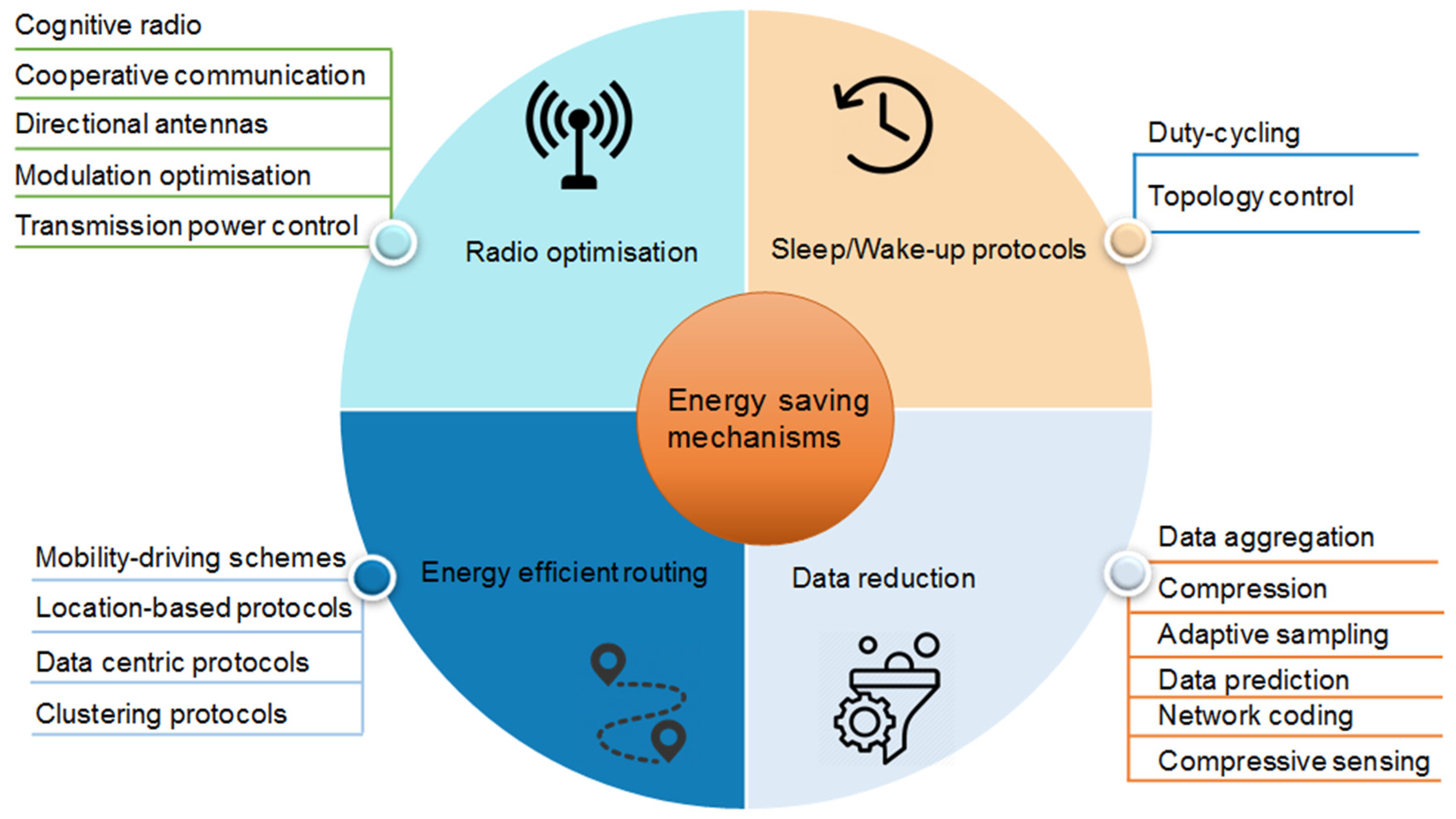
| Sources | Harvesting Methods | Power Density | Characteristics | Availability |
|---|---|---|---|---|
| Solar [17] | Photovoltaic | 15 mW/cm2 | Performance depending on the solar cell technology and on environmental conditions. Maximum power point tracking (MPPT) is needed. | Outdoor |
| <10 µW/cm2 | Indoor | |||
| Wind [20] | Electromechanical conversion | 0.1–6 mW/m3 | Impedance matching needed to achieve a good energy yield. | Outdoor |
| Vibration [6,14,15,18,20,21] | Piezoelectric/ electromagnetic/ electrostatic/ magnetoelectric conversion/ triboelectric vibration | 0.1–300 mW/cm3 | Performance depends widely in the vibration source properties (frequency, frequency bandwidth). Rectifier is needed. | Indoor/ Outdoor |
| Thermal [19] | Thermoelectric conversion | 40 µW/cm3 | Application needs to realize a sufficient temperature gradient. Impedance matching needed | Indoor/ Outdoor |
| Ocean waves [34] | Piezoelectric conversion Triboelectric conversion | 0.4–2 W/m2 12 W/m3 | Outdoor | |
| Acoustic noise [35] | Piezoelectric conversion Electromagnetic Conversion Triboelectric Conversion | 96 mW/cm3 | Indoor/ Outdoor | |
| RF [9] | Electromagnetic conversion | 0.1 µW/cm2 (GSM 900 MHz) 1 µW/cm2 (WiFi) | Impedance matching needed |
| Wireless Node Operation Mode | Panstamp NRG 2.0 [72,73] | Decawave DWM1000 [74] | 9XTend [75] |
|---|---|---|---|
| Off | 5 μA | - | 5 μA |
| Idle | - | 13.4 mA | 147 μA |
| Sleep | 1–2 μA | 200–550 nA | 1.6–10 mA |
| Transmission | 36 mA (868 MHz) | 111 mA (3.5 GHz) | - |
| Reception | 18 mA (868 MHz) | 154 mA (3.5 GHz) | - |
Publisher’s Note: MDPI stays neutral with regard to jurisdictional claims in published maps and institutional affiliations. |
© 2021 by the authors. Licensee MDPI, Basel, Switzerland. This article is an open access article distributed under the terms and conditions of the Creative Commons Attribution (CC BY) license (http://creativecommons.org/licenses/by/4.0/).
Share and Cite
Kanoun, O.; Bradai, S.; Khriji, S.; Bouattour, G.; El Houssaini, D.; Ben Ammar, M.; Naifar, S.; Bouhamed, A.; Derbel, F.; Viehweger, C. Energy-Aware System Design for Autonomous Wireless Sensor Nodes: A Comprehensive Review. Sensors 2021, 21, 548. https://doi.org/10.3390/s21020548
Kanoun O, Bradai S, Khriji S, Bouattour G, El Houssaini D, Ben Ammar M, Naifar S, Bouhamed A, Derbel F, Viehweger C. Energy-Aware System Design for Autonomous Wireless Sensor Nodes: A Comprehensive Review. Sensors. 2021; 21(2):548. https://doi.org/10.3390/s21020548
Chicago/Turabian StyleKanoun, Olfa, Sonia Bradai, Sabrine Khriji, Ghada Bouattour, Dhouha El Houssaini, Meriam Ben Ammar, Slim Naifar, Ayda Bouhamed, Faouzi Derbel, and Christian Viehweger. 2021. "Energy-Aware System Design for Autonomous Wireless Sensor Nodes: A Comprehensive Review" Sensors 21, no. 2: 548. https://doi.org/10.3390/s21020548
APA StyleKanoun, O., Bradai, S., Khriji, S., Bouattour, G., El Houssaini, D., Ben Ammar, M., Naifar, S., Bouhamed, A., Derbel, F., & Viehweger, C. (2021). Energy-Aware System Design for Autonomous Wireless Sensor Nodes: A Comprehensive Review. Sensors, 21(2), 548. https://doi.org/10.3390/s21020548












